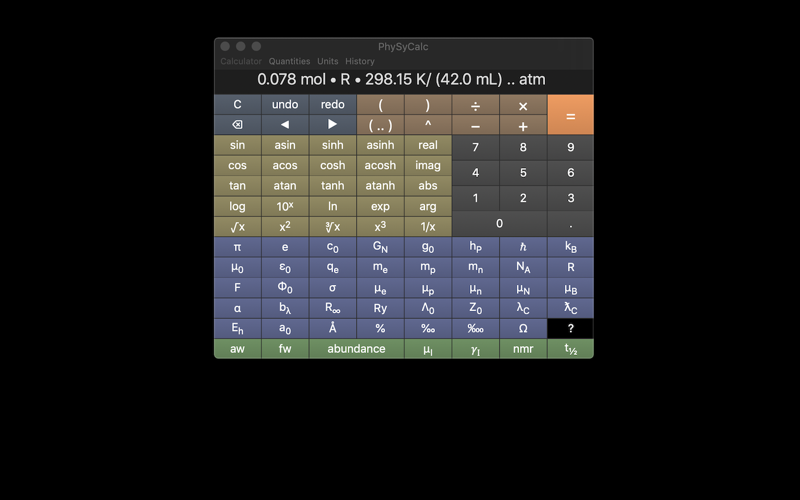
How is PhySyCalc different from other calculators? It allows you to include unit symbols in your calculations, obtaining the answer in the desired unit without those extra unit conversion steps. On top of this great simplification, PhySyCalc knows practically every fundamental physical constant. It even knows physical properties for elements and isotopes in the periodic table. This allows you to get numerical answers in the desired unit in a fraction of the time youd spend on a conventional calculator. PhySyCalc is quick to learn and easy to use. Cant remember a unit symbol? PhySyCalc helps you find and append commonly used units onto a number. PhySyCalc uses a natural infix notation for calculations. This means you can enter and read through the entire expression in full before calculating the result, helping you quickly identify and fix any input errors.
Not only does PhySyCalc save you time, it also saves you from mistakes. A conventional calculator will also give you a numerical answer, even if you accidentally multiplied instead of dividing. With PhySyCalc you’ll know right away that you entered the calculation wrong because the result will have the wrong units.
As a teaching tool PhySyCalc offers students better insights in the concepts of physical quantity, dimensionality, and units. A student using PhySyCalc soon understands the connections between the base SI quantities and all the derived quantities.
PhySyCalcs sole ambition is to be the worlds best scientific "pocket" calculator.
Below are some sample inputs and outputs of progressive complexity.
Add 2 centimeters and 2 inches and give the answer in centimenters
Input: “2 cm + 2 in .. cm”
Output: “7.08 cm”
Add 2 centimeters and 2 inches and give the answer in inches
Input: “2 cm + 2 in .. in”
Output: “2.78740157480315 in”
Multiply 3 teaspoons by 10 and give the answer in fluid ounces
Input: “3 tsp • 10 .. floz”
Output: “5 floz”
Calculate the rest mass energy of the electron in kiloelectronvolts
Input: “m_e•c_0^2 .. keV”
Output: “510.99894631902 keV”
Calculate the area in acres of a circle that has a radius of 1 mile. Recall Area = π•r^2
Input: “π•(1 mi)^2..ac”
Output: “2010.619298297468 ac”
Calculate the height in yards of a kite on 200 feet of string and flying at an angle of 40° with the ground. Recall right triangle relationship y = r•sin(angle).
Input: “200 ft • sin(40°) .. yd”
Output: “42.85250731243595 yd”
Calculate the volume in milliliters of 5 grams of carbon dioxide gas at 300 K and 989 mbar. Recall gas law: V = nRT/p.
Input: “(5 g/fw[CO2]•R•300 K)/(989 mbar)..mL”
Output: “2856.382301275785 mL”
Features include:
• Intuitive, minimal buttons in portrait display for ease and speed of use
• Calculations may be entered in full before evaluating
• Quantity units are supported in all calculations
• PhySyCalc even handles complex numbers!
• unlimited undo makes it easy to find mistakes and correct them.
• Convenient quantity menu helps you find the right unit for your problem.


